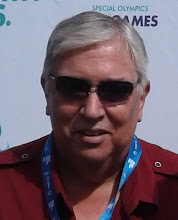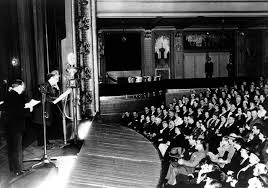"I Don't Even Know What I'm Talkin' About!": The Way It Was, 6 March
1906---And neither does anyone in the delivery room know what he's going to be talking about. They know only that the first sound out of the throat of Louis Francis Cristillo isn't, "Heeyyyyy, Abbaaaaaaaaaaattt!" when he is born today in Paterson, New Jersey.
He will seek and fail at finding film work in Hollywood beyond labour and extra work at MGM and Warner Brothers studios, before becoming a burlesque comic while stranded in St. Louis in 1930 (and, reputedly, refusing to deliver off-colour material), ultimately adopting the stage name Lou Costello, and working in the dying vaudeville during the decade, often as not as the immigrant who doesn't understand (and mangles accordingly) English.
During this period he will meet his future partner, Bud Abbott, for the first time, and making themselves a formal team (reputedly, at the explicit suggestion of Abbott's wife, Betty) in 1936.
The duo will make a signature out of Abbott's devious straight man and Costello's half-witted, language-challenged laugh-getter and a long enough career in radio (The Kate Smith Hour, The Chase & Sanborn Hour, and especially The Abbott & Costello Show), film, and (briefly enough) television. Their radio career will begin when they succeed Henny Youngman on Kate Smith's show and pick up when they begin as a summer replacement for Fred Allen in 1940---getting their own program two years later.
Costello will miss a year's work recovering from rheumatic fever (he was stricken in 1943), and the duo would feud in 1945 (reputedly, they will speak to each other on the air alone until the feud is patched up). Otherwise, they would remain a team through 1956, when Costello goes out on his own with Abbott semi-retiring.
Though Abbott & Costello will be perhaps the top drawing comedians in film in the 1940s, though their radio show will remain a popular attraction through much of the decade, not everyone will agree they were one of the classically innovative comedy teams of their time once their success was assured---or that they were always a pleasure to work for. Their major problem, apparently: they were petrified about doing much if any new material, or transcending the simple coordinates of their customary characters, as time and their fame went on.
They settled my contract for a lot of money. I insisted on that, 'cause they refused to do new material . . . Monte Hackett, the very prominent agent who got me the assignment, came to me and said, "The boys are afraid to do new material, Parke. I didn't know that" . . .. . . I got a script together. I was head writer. Whoever the writers were, I would compile a script, and put my own material in---after all, I was getting top money, so I had to have something by way of a contribution---and then I would give it to Costello. I think I was only two weeks with them. They didn't like any of the material. And I finally said, "Look, if you're not going to take a chance with new material, you don't need me. Let me out." I was on a firm thirteen-week contract as I recall. I forget whether I was getting $1,000 or $1,250 [a week]; I know it was up around $10,000 when they settled with me.---Parke Levy, one-time Abbott & Costello writer, to Joshua R. Young, for The Laugh Crafters: Comedy Writing in Radio and TV's Golden Age. (Beverly Hills: Past Time Publishing, 1999.)Maybe the best way to fathom the radio appeal of lowbrow clowns like Abbott and Costello is to note that they found their groove early and stuck to it doggedly, first on stage, then in radio, and finally in films and on TV, which revived their reputations.On radio, The Abbott & Costello Show remained true to the team's vaudeville roots, indulging in formulaic two-man repartee, often disguised in a bare-bones sketch . . . The first bit they ever did in radio became their most memorable, the classic "Who's on First?" routine that nailed down their place in comedy history and enshrined them in baseball's Hall of Fame, where their exchange still runs on a continuous loop. It was supposedly written into their radio contract that they must perform the bit once a month on their show.---Gerald Nachman, in Raised on Radio. (New York: Pantheon Books, 1998.)We took a molehill and made a mountain out of it.---Bud Abbott.
Further disruptions to the team's momentum will include Bud Abbott's heavy drinking (reputedly, his way of trying to salve the epilepsy he battled all his life), both men's gambling, eventual tax debts (their tax trouble will force both to sell their homes, their percentages of their films, and Costello's percentage of their television show) that ruin both men*, and the accidental death of Costello's infant son, from which associates believe he never really recovers before his death (at 52) of heart failure.
* - Bud Abbott told Screen Stories magazine in 1960 that Lou Costello, thanks to his majority ownership in their television series, may have had something left after all once he settled with the tax man. Which made him luckier than Abbott, who still owed short of $100,000 in back taxes, pending the sale of his home, at the time the interview was published.
Lou Costello died in 1959; his wife, Anne, died shortly thereafter following her own long battle with the bottle---a battle that may make a little more clear why Costello might have been somewhat harsh regarding Abbott's heavy drinking. Bud Abbott died of cancer in 1974---still broke.
And, just to clarify once and for all, Abbott & Costello, pace Mr. Nachman, are not and never have been inducted members of the baseball Hall of Fame . . .
CHANNEL SURFING . . . *
1951: BOB HOPE MEETS THE RIGHT STUFF---That's then-Capt. Chuck Yeager, on whose home turf the Hope aggregation records the week's show, the desert installation known at the time as Muroc Air Force Base ("Where never is heard a discouraging word---and everyone applies for a transfer") but destined to become far more famous as Edwards Air Force Base---to which Hope is lined up to fly supersonic with Yeager himself, after which he needs partial resuscitation from Ava Gardner, on tonight's edition of The Bob Hope Show. (NBC.)
Additional cast: Hy Averback, Connie Haines. Music: Les Brown and his Band of Renown. Writers: Larry Gelbart and Larry Marks, or Marvin Fisher and Al Schwartz.
NOTE: This is the same Hy Averback who will become a successful television producer (Ensign O'Toole, F Troop, The Dukes of Hazzard) and director (episodes of The Rogues, McMillan and Wife, McCloud, and M*A*S*H---on which he was also a voice millions knew with no identification, until he blurted it out at the end of one episode: he was the loudspeaker voice in the first season.)
PREMIERING TODAY . . .
1882---Guy Kibbee (actor: Lux Radio Theater), El Paso, Texas.
1885---Rosario Bourdon (conductor: Cities Service Concert/Cities Service Highway of Melody), Longuereil, Quebec.
1900---Jay C. Flippen (announcer: Battle of the Sexes, Major Bowes and His Original Amateur Hour, Stop Me If You've Heard This One), Little Rock, Arkansas.
1916---Virginia Gregg (actress: Ellery Queen, Let George Do It, One Man's Family, Richard Diamond, Private Detective), Harrisburg, Illinois; Rochelle Hudson (actress: Hollywood Hotel), Oklahoma City.
1917---Frankie Howard (comedian: The Frankie Howard Show), York, U.K.
1923---Ed McMahon (announcer: NBC Monitor), Detroit.
1930---Lorin Maazel (conductor: NBC Summer Symphony), Paris.
1885---Rosario Bourdon (conductor: Cities Service Concert/Cities Service Highway of Melody), Longuereil, Quebec.
1900---Jay C. Flippen (announcer: Battle of the Sexes, Major Bowes and His Original Amateur Hour, Stop Me If You've Heard This One), Little Rock, Arkansas.
1916---Virginia Gregg (actress: Ellery Queen, Let George Do It, One Man's Family, Richard Diamond, Private Detective), Harrisburg, Illinois; Rochelle Hudson (actress: Hollywood Hotel), Oklahoma City.
1917---Frankie Howard (comedian: The Frankie Howard Show), York, U.K.
1923---Ed McMahon (announcer: NBC Monitor), Detroit.
1930---Lorin Maazel (conductor: NBC Summer Symphony), Paris.












0 Comments:
Post a Comment
Subscribe to Post Comments [Atom]
<< Home